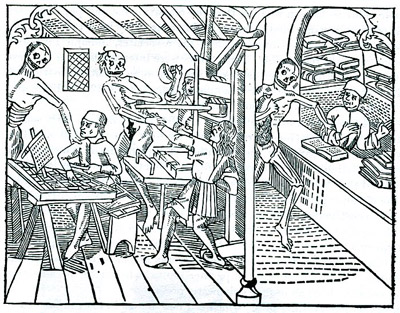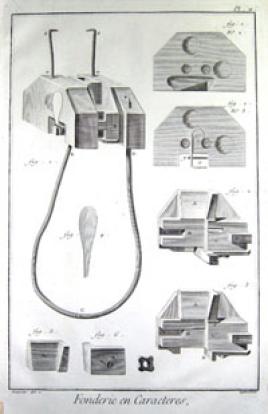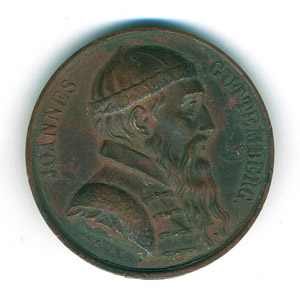 All of us “know” that the invention of printing was an epochal development in human civilization. Gutenberg and/or his invention of circa 1439-40 ranked at the top or very near the top of the lists of “greatest” of the millennium that journalists eagerly compiled. But how much do we really know?
All of us “know” that the invention of printing was an epochal development in human civilization. Gutenberg and/or his invention of circa 1439-40 ranked at the top or very near the top of the lists of “greatest” of the millennium that journalists eagerly compiled. But how much do we really know?
Whenever I reach this topic on my syllabus, I ask my students: Just what was this achievement? They invariably give me a set of increasingly specific answers: printing? the printing press? movable type? I reply, variously: “nope,” or “close, but no cigar” (often adding: the Chinese had that centuries earlier).
So, I tell them: printing on a press with movable type made from matrices. (Huh?) This latter was the key. In simple terms: Gutenberg found a way to cut raised letters into hard metal on the end of a punch that was driven into soft metal, which, when placed in a mould, produced identical relief copies of each  letter on metal shanks of uniform height and body but varying width. In order to print with these, he needed, in addition, a durable low-temperature lead-tin-antimony alloy, porous paper (again, a Chinese invention), fatty-based ink, and a new type of screw press with just the right type of motion and amount of pressure. Gutenberg’s accomplishment was thus that of invention, but also combination. He solved a problem by drawing upon technological developments in several domains to create something qualitatively new.
letter on metal shanks of uniform height and body but varying width. In order to print with these, he needed, in addition, a durable low-temperature lead-tin-antimony alloy, porous paper (again, a Chinese invention), fatty-based ink, and a new type of screw press with just the right type of motion and amount of pressure. Gutenberg’s accomplishment was thus that of invention, but also combination. He solved a problem by drawing upon technological developments in several domains to create something qualitatively new.
And what of its impact? A generation ago, Elizabeth Eisenstein made the most persuasive and impassioned (though still not uncontroversial) case for “the printing press as an agent of change”: preserving knowledge, fixing the content of texts, and facilitating intellectual exchange and debate. In her view, printing allowed the classical revival of the fifteenth and sixteenth centuries to achieve permanence in a way that earlier ones did not, and made it impossible for the flames of the Protestant Reformation to be squelched, as were those of all the preceding heresies. As she puts it, both of these movements, initially intended to recapture a golden past, became reoriented in ways that took them toward the creation of something genuinely new. Printing further helped to make possible new forms of scientific inquiry that demanded the collection and comparison of quantitative and graphic evidence.
It’s easy to get carried away. Celebrating Gutenberg as the man of the millennium, Time Magazine declared, “Affordable books made literacy a crucial skill and an unprecedented means of social advancement.” Well, no. To say that cheap books made people want to read is like saying that Ford’s cheap Model T made people want to go places. Or, to stay with the transportation metaphor, it’s putting the cart before the horse. The desire may have been enhanced, but it first had to exist. The fact is: until fairly recently, most people did not need to be literate.
“Affordable books made literacy a crucial skill and an unprecedented means of social advancement.” Well, no. To say that cheap books made people want to read is like saying that Ford’s cheap Model T made people want to go places. Or, to stay with the transportation metaphor, it’s putting the cart before the horse. The desire may have been enhanced, but it first had to exist. The fact is: until fairly recently, most people did not need to be literate.
In thinking about Gutenberg’s invention and the media revolution unfolding around us today, we would therefore be well advised to bear in mind the importance of interest as well as knowledge, and continuity as well as change. M. T. Clanchy interprets the book as part of the medieval legacy, which printing—the end of an old development rather than the beginning of a new one—merely extended.
Now, as then, the aesthetics and content of the new form mimicked those of the old. The difference is that digital media present us with a new technology of use as well as production. By contrast, one “operated” (in Daniel Traister’s memorable phrase) manuscript and print books in exactly the same way. The real shock, as a very funny and widely circulated video reminded us a couple of years ago, was the earlier transition from scroll to codex. In that sense, printing introduced no revolution.
Gutenberg moreover needed not just an idea, but also a market. Unlike a scribe, who could produce a single copy or handful of copies on demand, the printer, who had an investment in both overhead and project costs, had to produce and sell at least several hundred copies of a given work, by guessing in advance what the public wanted. Not surprisingly, the first print genres tended to recapitulate older tastes and patterns: for the elites, sacred, learned, and bureaucratic Latin texts, alongside a smaller body of vernacular literacy (largely religious). It is no coincidence, then, that the most famous work attached to Gutenberg’s name is a Latin bible (Göttingen; Keio; British Library copies).
As in the more recent shift from analog to digital audiovisual media: businesses aimed at known tastes and brought out the steady sellers in a new format. In the process, admittedly, they winnowed and sifted and left some works behind, but at the same time, they began to speculate on new markets, tried to satisfy or create new demand. Columbus’s “Letter on the Newly Found Lands” spread across the continent in the space of a few months in 1493. Luther’s works alone made up about a third of the German market in the first half of the sixteenth century. Paradoxically, the ability to produce a text in numerous copies made it easier for authors to disseminate new ideas—and yet a process requiring an investment, equipment, and networks of suppliers and purchasers also gave the authorities new opportunities for control. Censorship followed close on the heels of printing.
Even in an ideal world of total freedom of expression, challenges would remain. Today, anyone can print a pamphlet and create a web page or blog at minimal expense, yet we still face some of the same problems that confronted Gutenberg. Long before the advent of printing, the ancient Romans asked, “quis leget haec?” Who will read these?
IMAGES, top to bottom:
(1) First known depiction of a printing press: from the Dance of Death by Matthias Hus (Lyon, 1499). The design and principles of the handpress barely changed in the 350 years after Gutenberg's invention–according to one intriguing theory, because printers regarded the press as a tool rather than a machine.
(2) The genius of Gutenberg's invention: parts of the typefounder's mould, from the Encyclopedia of Diderot and d'Alembert (1763). The process of casting letters did not change until the onset of industrialization in the 19th century.
(3) French medal celebrating Gutenberg (1818), from a series devoted to great figures in history. We have no idea what he actually looked like, or exactly when he was born: probably between 1393 and 1403, but scholars in 1900 settled on 1400, which also conveniently allowed his 600th birth anniversary to fall in the year 2000. The traditional depiction of Gutenberg whith long pointed beared and fur-lined coat and hat derives from a late 16th-century print, which, like his birthdate 1400, represents something between a guess and wish.


